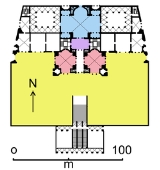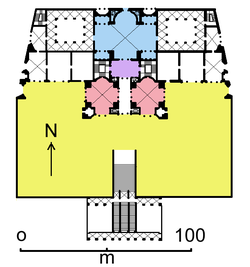
Baths of Titus
Encyclopedia

Thermae
In ancient Rome, thermae and balnea were facilities for bathing...
) built in Rome
Rome
Rome is the capital of Italy and the country's largest and most populated city and comune, with over 2.7 million residents in . The city is located in the central-western portion of the Italian Peninsula, on the Tiber River within the Lazio region of Italy.Rome's history spans two and a half...
in 81
81
Year 81 was a common year starting on Monday of the Julian calendar. At the time, it was known as the Year of the Consulship of Silva and Pollio...
by Emperor Titus
Titus
Titus , was Roman Emperor from 79 to 81. A member of the Flavian dynasty, Titus succeeded his father Vespasian upon his death, thus becoming the first Roman Emperor to come to the throne after his own father....
.
The baths sat in the base of the Esquiline hill
Esquiline Hill
The Esquiline Hill is one of the celebrated Seven Hills of Rome. Its southern-most cusp is the Oppius .-Etymology:The origin of the name Esquilino is still under much debate. One view is that the Hill was named after the abundance of holm-oaks, exculi, that resided there...
, an area of parkland and luxury estates which had been taken over by Nero (54–68) for his Golden House or Domus Aurea
Domus Aurea
The Domus Aurea was a large landscaped portico villa, designed to take advantage of artificially created landscapes built in the heart of Ancient Rome by the Emperor Nero after the Great Fire of Rome had cleared away the aristocratic dwellings on the slopes of the Palatine...
. Thermae Titi or Titus' baths were built in haste, possibly by converting an existing or partly built bathing complex belonging to the reviled Domus Aurea. They were not particularly extensive, and the much larger Baths of Trajan
Baths of Trajan
The Baths of Trajan were a massive thermae, a bathing and leisure complex, built in ancient Rome starting from 104 AD and dedicated during the Kalends of July in 109...
were built immediately adjacent to them at the start of the next century.
One of the features of the baths was mural designs executed by the artist Famullus (aka Fabullus), both al fresco and al stucco. Before they fell into decline from exposure to the elements they were copied by Nicholas Ponce and reproduced as engravings in his volume "Desription des bains de Titus" (Paris, 1786). The designs are now recognized as a source of the style known as "grotesque
Grotesque
The word grotesque comes from the same Latin root as "Grotto", meaning a small cave or hollow. The original meaning was restricted to an extravagant style of Ancient Roman decorative art rediscovered and then copied in Rome at the end of the 15th century...
" (meaning "like a meaning a small cave / a hollow / a grotto" ... because the ruins of the Baths of Titus were a hollow in the ground when they were discovered).
See also
- Baths of DiocletianBaths of DiocletianThe Baths of Diocletian in Rome were the grandest of the public baths, or thermae built by successive emperors. Diocletian's Baths, dedicated in 306, were the largest and most sumptuous of the imperial baths. The baths were built between the years 298 AD and 306 AD...
- Baths of CaracallaBaths of CaracallaThe Baths of Caracalla in Rome, Italy were Roman public baths, or thermae, built in Rome between AD 212 and 216, during the reign of the Emperor Caracalla.- History :...
- Baths of TrajanBaths of TrajanThe Baths of Trajan were a massive thermae, a bathing and leisure complex, built in ancient Rome starting from 104 AD and dedicated during the Kalends of July in 109...
- Roman aqueducts
- Roman engineeringRoman engineeringRomans are famous for their advanced engineering accomplishments, although some of their own inventions were improvements on older ideas, concepts and inventions. Technology for bringing running water into cities was developed in the east, but transformed by the Romans into a technology...
- ThermaeThermaeIn ancient Rome, thermae and balnea were facilities for bathing...

